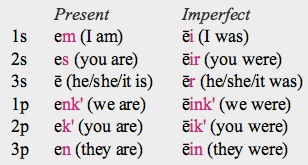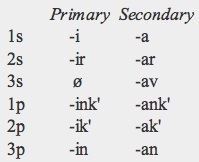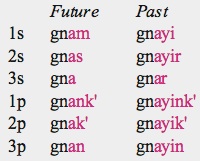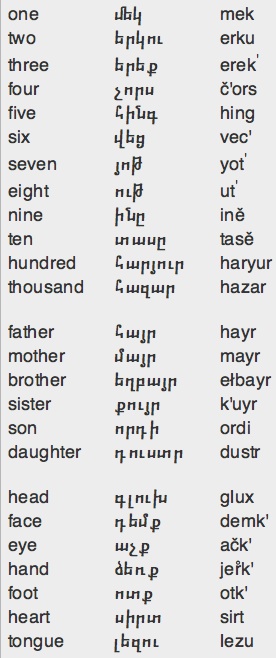An insatiable appetite for ancient and modern tongues


Classification: Armenian constitutes on its own a separate branch within the Indo-European family.
Overview. Armenian is the language of the Armenian people who arrived in Anatolia at an unknown date, probably in the late second millennium BCE. At the beginning of the sixth century BCE they became the successors of the Urartians, a non-Indo-European people that have settled the areas surrounding Lakes Van, Urmia and Sevan in northeastern Anatolia, northwestern Iran and what is now the country of Armenia. The names Armina and Armaniya appear for the first time in the Persian inscription of Darius the Great at Behistun.
Armenian is not closely related to any other Indo-European language though it shows some affinities with Greek and the Indo-Iranian branch. Besides, it has been heavily influenced by Balkan languages and Turkish in its morphology and syntax.
Distribution: Armenia, Russia, Georgia, Nagorno-Karabakh Republic (recognized by few countries), Iran (province of Azerbaijan), Syria and Lebanon (see Indo-European map). There are only a few remaining speakers in Eastern Turkey. Armenian emigrants live in many European countries, the Middle East and North America.
Speakers. Armenian is spoken by about 6.5 million people in the following countries:
Armenia
Russia
Georgia
Syria
Lebanon
USA
Iran
Nagorno-Karabakh
Egypt
France
Iraq
Turkey
Canada
Bulgaria
3,200,000
1,100,000
450,000
300,000
250,000
203,000
171,000
152,000
100,000
70,000
60,000
60,000
33,000
27,000
Status. Armenian is the official language of Armenia and of the the facto Republic of Nagorno-Karabakh. It was spoken by a large community in Turkey but almost all of the Armenian Turks were massacred or deported by Ottoman Turks in 1915.
Varieties. It has two main ones. Eastern Armenian, based on the dialect of the Ararat valley and the city of Yerevan, is spoken in Armenia and is the standard language. Western Armenian, based on the dialect of Istanbul, is spoken in Turkey and by Armenian communities in the diaspora. These two forms are mutually intelligible.
Oldest Documents. They date back to the fifth century CE following the conversion of the Armenians to Christianity at the beginning of the 4th century CE and the creation of the Armenian alphabet. They consist of a translation of the Bible and other Christian texts.
Periods
Classical Armenian: the language into which the Bible was translated in the 5th c. CE and that is the ritual language of the Armenian Church.
Middle Armenian (11th to 15th centuries CE). In the medieval period appeared most of the changes found in Modern Armenian.
Modern Armenian (15th century to the present).
Phonology
Armenian diverged significantly from Proto-Indo-European in terms of pronunciation. It has been influenced by Georgian and other Caucasian languages.
Syllable structure: syllables can be either open (ending in a vowel) or close (ending in consonant). Consonantal clusters can be found in initial, medial or final position
Vowels (6). Classical Armenian had seven vowels and Modern Eastern Armenian has six:

Eastern Armenian has no real diphthongs but glide-vowel combinations: [ɑj], [uj], [ɛj], [ɔj], [jɑ] [jɔ] [ju].
Consonants (32). Modern Eastern Armenian has three series of stops and affricates: voiceless unaspirated, voiceless aspirated, and voiced. It has four pairs of fricatives, each pair contrasting voiceless and voiced sounds, plus a glottal voiceless one. Two other pairs of sounds are the two contrastive rhotics (r-like sounds), and laterals (l-like sounds). The rolled r or trill [r] is rare in initial position while the weaker flap [ɾ] occurs in all positions. One of the two lateral sounds is palatalized or velarized [ł].

Stress: may fall on any syllable but most frequently on the last one.
Script and Orthography
Armenian is written in an alphabet, well suited to its phonology, invented by Meshrop Mashtots in 404-407 CE. Originally, it contained 36 letters but three more were added later. Below each letter is shown its transliteration into the Latin alphabet and, between brackets, its equivalent in the International Phonetic Alphabet.

Morphology
Modern Armenian morphology is typologically close to Turkish, as shown by an agglutinative system of declension, the use of suffixes to indicate possession, the existence of passive and causative forms for all verbs and the use of postpositions instead of prepositions.
-
Nominal. Nominal morphology in Proto- and Classical Armenian was rich; they preserved the Indo-European nominative, accusative, genitive, dative, instrumental, ablative, and locative cases, in both singular and plural though, the dual was lost. There were at least eight different declensions, distinguished primarily by different theme vowels. By the medieval period, this system was significantly reduced and the modern varieties have the same endings in singular and plural. With the exception of pronouns, the inventory of cases has been significantly reduced. The noun structure is: stem-plural suffix-case ending-definiteness/possessiveness suffix.
-
•gender: there is no gender distinction in Modern Eastern Armenian but the language distinguishes between human and non-human nouns (animals, plants and objects). This distinction is important for the case assignment of the direct object (see the syntax section below).
-
•number: singular, plural. The Indo-European dual was lost. The plural is formed with the suffix -(n)er attached to the noun stem; -er is generally suffixed to monosyllabic nouns and -ner to polysyllabic nouns. There are other plural suffixes (-ik, -ayk', -k') but they are only used with certain nouns and contexts. For personal names the most frequent plural suffix is -enk'.
-
•case: nominative, dative, ablative, instrumental, locative.
-
The seven cases of the classical language have been reduced in Modern Armenian to these five. The accusative has merged with the nominative, and the genitive with the dative. Declensions are indicated by case endings attached directly to the noun stem in the singular, and after the plural suffix in the plural. Seven types of nominal declension exist in Modern Eastern Armenian, distinguished by the dative singular ending: -i, -u, -an, -va, -oǰ, -a, -o. In the plural the case endings are the same for all nouns.

-
-i declension: the majority of nouns decline according to this group which is the most productive and the most frequently used in colloquial Armenian.
-
-u declension: in the dative singular the ending is u(n) and in the ablative is uc'.
-
-oǰ declension: in the dative singular the ending i(n) is replaced by oǰ(ě).
-
-an declension: in the dative singular the ending i(n) is replaced by an(ě), and, if the noun has u in the last syllable it is lost in this case (mank instead of manuk in the example).
-
-va declension: in the dative singular the ending i(n) is replaced by va(n) and in the ablative the ending ic' is preceded by van (van-ic').
-
-a declension: in the dative singular the last vowel of the radical changes into a (ankyan instead of ankyun in the example).
-
-o declension: the dative singular changes the vowel of the radical; the ablative and instrumental endings are attached to the dative root. This group includes a few kinship terms such as father, mother and brother.
-
•adjectives: can be attributive or predicative, in both functions they do not agree with their noun in number and case. In attributive function they generally precede their head noun. The degrees of comparison of qualitative adjectives are:
-
basic level: is expressed by the bare adjective e.g. mec tun (‘a big house’).
-
comparative: the intensifier aveli is preposed to the adjective, or the object of comparison is declined in the ablative case, or it is expressed with the construction than... e.g. aveli mec tun (‘a bigger house’).
-
superlative: formed with amena prefixed to the adjective or with the suffix aguyn e.g. amena-mec tun-(ě) (‘the biggest house’).
-
•pronouns: personal, possessive, demonstrative, reciprocal, indefinite, interrogative, relative.
-
Personal pronouns are marked for case but the nominative is only used for emphasis. The third person pronoun is the demonstrative na.

-
Possessive pronouns are the genitive forms of the personal pronouns.
-
Demonstrative pronouns have a three-way deictic distinction: sa (proximal), da (distal), na (remote). For example:
-
-
Sa im girk' ē
-
This my book it is
-
Demonstrative pronouns in red, possessive pronouns in blue.
-
Da k'o girk' ē
-
That your book it is
-
Na nra girk' ē
-
That his book it is
-
Demonstrative pronouns are inflected in the same way as the 3rd person pronoun. For sa:

-
Da and na have the same inflection pattern.
-
Reciprocal pronouns express a mutual action among the referents of a plural subject. There are three reciprocal pronouns: irar (‘each other, one another’), mimyanc' (‘each other’), mekmeku (‘one another’). They are also inflected but they have neither nominative nor locative.
-
Interrogative pronouns and adverbs: ov (‘who?’), inč' (‘what?’), or (‘which?’), erb (‘when?’), ur, orteł (‘where?’), inč'u (‘why?’), inč'pes (‘how?’), k'ani (‘how many?, how much?’).
-
Indefinite pronouns: some examples are, omank’ (‘some, some people’), mekĕ/meknumekĕ (‘someone’), orewē mekĕ (‘anybody’), inč'-or mekĕ (‘somebody’), inč'-or ban (‘something’), orewē ban (‘anything’), omn (‘anyone’), erbewicē (‘sometime, ever’), etc.
-
Relative pronouns: interrogative pronouns may be used as relative pronouns in relative clauses:
-
-
ayn partezĕ orteł šat całikner k-an
-
that garden where many flowers exist
-
Verbal. The Armenian verb is composed by a stem plus morphological suffixes and, sometimes, lexical suffixes. The different verbal forms are generated either from the present stem or the aorist stem.
-
The present stem is the infinitive without the endings -el or -al. For example: in grel (‘to write’) the stem is gr; in kardal (‘to read’) the stem is kard.
-
The aorist stem is the same as the present stem for verbs ending in el, but for verbs ending in al the aorist stem is formed with the present stem plus the ending ac'. For example, in grel the aorist stem is gr; in kardal it is kardac'.
-
There are two conjugations: the a-conjugation where the thematic vowel is a, and the e-conjugation where the thematic vowel is e.
-
•person and number: 1s, 2s, 3s; 1p, 2p, 3p.
-
•tense: present, imperfect, aorist, present perfect, past perfect, future, future in the past.
-
Most tenses are periphrastic i.e they are formed with a participle + the auxiliary verb em (‘be’). They are formed in the following way:
-
‣Present and Imperfect: the present participle + auxiliary verb em inflected in present and imperfect, respectively.
-
‣Present and Past Perfect : the perfect participle + auxiliary verb em inflected in present and imperfect, respectively.
-
‣Future and Future in the past: the future participle + auxiliary verb em inflected in present and imperfect, respectively.

-
The conjugation of the auxiliary verb em (‘be’) is as follows (personal endings in red):
-
Example: 'Anuš is writing' is said:
-
-
Anuš-ĕ gr-um ē
-
Anuš-the write-pres. part. she is

-
The Aorist is the only synthetic tense. It is formed with the aorist stem plus primary endings for verbs suffixed with -el or -al or secondary endings for verbs suffixed with -enal or -anal:
-
Negation is done by prefixing the negative particle č' to the conjugated verb or to the auxiliary in periphrastic tenses.
-
•aspect: perfective (completed), imperfective (not completed), habitual-iterative, progressive (ongoing action), durative, non-durative.
-
•mood: indicative, subjunctive (optative), conditional, debitive, imperative.
-
The subjunctive is used to express wish, hypothesis, doubt, probability, etc. The conditional expresses conditions or concessions in future actions or states. The debitive expresses the subject's obligation to perform an action. The imperative has only 2s and 2p. In the singular it is formed with the present stem + a (a-conjugation) or ir (e-conjugation). There is also a hortative form for the 1p.

-
The subjunctive, conditional and debitive have two tenses each: future and past. The subjunctive is formed with the present stem plus specific personal endings (in red):
-
The conditional is identical to the subjunctive except for having the modal prefix k- (k-gnam, etc).
-
The debitive is identical to the subjunctive except for being prefixed by the particle piti (piti-gnam, etc).
-
•voice: active, passive, reflexive, reciprocal.
-
•non-finite forms: infinitive, and several participles.
-
‣The infinitive is formed with the present stem plus the endings -el or -al (gr-el; kard-al).
-
‣The present participle is formed with the present stem plus -um for all conjugations (gr-um, kard-um). It expresses an action in progress or an action in present time ("writing", "reading").
-
‣The perfect participle is formed with the aorist stem plus the suffix -el (gr-el). It expresses an action that has been completed in the past.
-
‣The future participle is formed with the infinitive plus the suffix -u (grel-u, kardal-u). It has a potential meaning or refers to an action to be performed in the future.
-
‣The negative participle is formed with the infinitive stem plus the suffix -i in the e-conjugation (gr-i) or -a in the a-conjugation (kard-a). It negates the subjunctive mood and it is used exclusively in this function.
-
‣The subject participle is formed with -oł suffixed to the present stem in e-conjugation verbs (gr-oł) or to the aorist stem in a-conjugation verbs. This participle functions as an adjective of a subject noun.
-
‣The resultative participle is formed with -ac suffixed to the present stem of e-conjugation verbs (gr-ac) or to the aorist stem of a-conjugation verbs. It indicates the state that results from an action.
-
‣The progressive participle is formed with the infinitive + suffix -is (grel-is, kardal-is). This participle expresses an action in progress independent of the tense of the main verb.
-
•compounding: the use of compound words is extensive. They usually include a single lexical verb plus another lexical item which can be a noun, an adverb or an adposition.
Syntax
Syntactical function is conveyed by cases and postpositions. The subject agrees with the finite verb in person and number. Direct objects are marked with the nominative when they are non-human and with the dative case when human. The indirect object is marked with the dative.
Armenian is a pro-drop language (subject personal pronouns can be omitted) as the number and person of the subject is marked on the conjugated verb.
Armenian has a flexible word order. In declarative sentences the neutral word order is Subject-Predicate-Verb (SPV), but when the subject is in focus, the word order is SVP. An example of SPV neutral order:
-
agr̊av-ĕ carav-el ēr
-
crow-the be thirsty(perf. partic.) was
When the subject is in focus it is positioned just before the verb (SVP):
-
agr̊av-n ēr carav-el
-
crow-the was be thirsty(partic. perf.)
Interrogative sentences can be made with a change in intonation pattern, with interrogative wh-pronouns, or in writing with a question mark.
Sentences are coordinated by conjunctions (ew, u [‘and’]; t'e [‘or’]; bayc' [‘but’], etc.), or by a comma or by a change of intonation.
Subordinate sentences may be introduced with subordinating conjunctions, or with relative or interrogative pronouns. The subordinate clause may be also introduced by the conjunction "that" with its verb in the subjunctive.
Lexicon
Armenian has many loanwords from Persian, Greek, Syriac and Arabic. The majority of words borrowed from Persian were incorporated into Armenian before the creation of the written language. Large numbers of Arabic words entered the language, in the 7th c., after the expansion of the Arabs in the Middle East, and thousands of Turkish words were incorporated, at the beginning of the 11th c., following the arrival of Turkic tribes in Anatolia.
Basic Vocabulary

Key Literary Works (forthcoming)
-
© 2013 Alejandro Gutman and Beatriz Avanzati
Further Reading
-
-Armenian: Modern Eastern Armenian. H. Dum-Trugut. London Oriental and African Language Library 14. John Benjamins (2009).
-
-'Armenian'. R. Ajello. In The Indo-European Languages, 197–227. A. G. Ramat & P. Ramat (eds). Routledge (1997).
-
-An Introduction to Classical Armenian. R. Thomson. Caravan Books (1975).
-
-'Classical Armenian'. J. P. T. Clackson. In The Ancient Languages of Asia Minor, 124–144. R. D. Woodward (ed). Cambridge Univeristy Press (2008).
-
-The Phonology of Armenian. B. Vaux. Oxford University Press (1998).
Armenian

Address comments and questions to: gutman37@yahoo.com
MAIN LANGUAGE FAMILIES
LANGUAGE AREAS
Languages of Ethiopia & Eritrea
LANGUAGES by COUNTRY
LANGUAGE MAPS
-
• America
-
• Asia
-
Countries & Regions
-
-
Families
-
• Europe
-
• Oceania